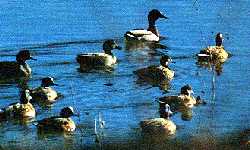
Jacques Marsh:
A Created Wetland in Northeastern ArizonaSite DescriptionThe created wetlands at Jacques Marsh are located 1 mile north of the town of Pinetop-Lakeside, Arizona. This is in the high country of northeastern Arizona. The wetlands are on National Forest Service Lands administered by the Apache/Sitgreaves National Forests.
|
|||||||||||||||
| Weather Summary | ||||
| Month | Average High Temp. |
Average Low Temp. |
Historic Record Low |
Average Precip. |
| Jan Feb Mar Apr May Jun Jul Aug Sep Oct Nov Dec |
44.3°F 46.1°F 50.0°F 59.7°F 69.0°F 78.1°F 80.5°F 77.5°F 74.4°F 65.6°F 53.6°F 46.5°F |
16.0°F 18.1°F 21.7°F 27.9°F 33.8°F 40.7°F 49.1°F 48.1°F 41.6°F 32.6°F 23.4°F 18.2°F |
-23.0°F -18°F -13°F 0°F 8°F 20°F 20°F 32°F 21°F 6°F -3°F -18°F |
1.92" 1.30" 1.91" .93" .43" .57" 3.13" 3.40" 1.82" 1.89" 1.34" 1.96" |
The clay soils of the Jacques Marsh site are of volcanic origin. They have low permeability to water. This is a key factor in the wetland design. The natural soils were used to form the marsh basins.
The natural vegetation of the site was ponderosa pine, Utah juniper and pinyon pine. This is a very common vegetation type in this mountain area. The animals occurring in this area include rocky mountain elk, mule deer, Merriam turkey, black bear, and coyotes. Common birds are Stellars jay, western bluebird, redshafted flicker, and raven. Waterfowl are common where water occurs. The Intermountain Biotic Province is the greatest source of waterfowl using this site.
Learn more about Jacques Marsh ~ Site Design & Construction
For more information, please feel free to contact the USDA Forest Service, Lakeside Ranger District at 520.368.5111 or you may write us at 2022 W. White Mtn. Blvd., Pinetop-Lakeside, Arizona 85935
White Mountains Online wishes to express our appreciation to the USDA Forest Service, Lakeside District for providing this information! This and other articles may be found in print media entitled:
Constructed Wetlands for Wastewater Treatment and Wildlife Habitat
United States Environmental Protection Agency
#EPA832-R-93-005
September 1993
 The climate has a dominant
influence on the functions of the created wetlands. This area has four definite
seasons. Spring is very windy with gusts over 50 mph. This can cause severe
bank erosion if vegetation isn't established. Net evaporation can exceed 7
inches per month in May and June. Summer is characterized by the onset of a
monsoon type pattern with frequent showers and high humidities. Plants respond
quickly to the higher night time temperatures. Fall is ushered in as the
rainfall diminishes and nights get colder. The first frosts occur during the
last part of September. Winter is marked by colder temperatures and the
wetlands freeze over. Ice may occur for 1 to 2 months of winter. Snow depths of
6 to 16 inches are common.
The climate has a dominant
influence on the functions of the created wetlands. This area has four definite
seasons. Spring is very windy with gusts over 50 mph. This can cause severe
bank erosion if vegetation isn't established. Net evaporation can exceed 7
inches per month in May and June. Summer is characterized by the onset of a
monsoon type pattern with frequent showers and high humidities. Plants respond
quickly to the higher night time temperatures. Fall is ushered in as the
rainfall diminishes and nights get colder. The first frosts occur during the
last part of September. Winter is marked by colder temperatures and the
wetlands freeze over. Ice may occur for 1 to 2 months of winter. Snow depths of
6 to 16 inches are common.